 Written by Mike Price, OT
Written by Mike Price, OT
When choosing any assistive device for your child, you’re not looking for a one-size-fits-all solution. Your child is unique, with unique needs; plus, your child is growing and changing! There are several design options available, and each of the pediatric standers on our list has valuable features and benefits.
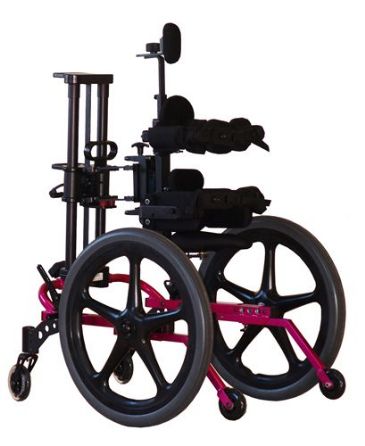 | 1) KidWalk II Dynamic Mobility System View Product |
A self-propelled model provides a child who can stand the opportunity to move independently. Generally, mobile standers have large wheels that are engaged like they would be in a wheelchair.
If your child cannot stand at all, a passive stander is the best choice. The child can move with assistance from a caregiver, but this design is for children who can’t move on their own.
A child who has good head and neck control can use an upright pediatric stander to attain a fully upright position.
For a child who doesn’t have good head and trunk control, a supine stander provides for semi-reclined positioning.
There are pediatric standers that allow you to move between upright and supine positions.
There are functional supports available with pediatric standers to assist children with low muscle tone or limited limb control. These available supports include foot loops, footrests, chest straps, body harnesses, chin rests, headrests, and hip guides. These padded aids are usually height adjustable and help keep your child upright with comfortable support tailored for individual needs.
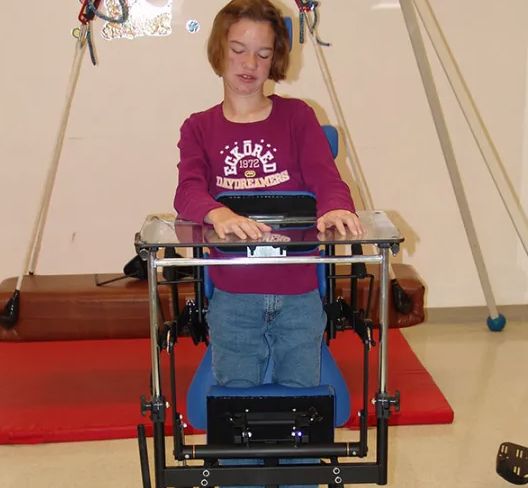
For home use, the only considerations are positioning and mobility. However, other factors come into play if a pediatric stander will be used at school. At home, a caregiver will be the main person who is with the child using the stander.
At school, a pediatric stander can be used as a tool for learning and socialization. When put into service as a learning and socialization tool, additional factors come into play. One feature that is very useful at school that wouldn’t make as much of an impact at home is a “shadow tray,” which can be used as a desk for holding books or other school supplies, or as a meal tray.
For an independently mobile child, the ability to move from one place to another with the assistance of a stander will positively impact cognitive, developmental, and social skills. If a child is independently mobile, consider a stander offering additional features. Moving independently in the school or daycare setting will multiply a child’s social, developmental, and cognitive gains.
Since toddlers to teenagers who have finished growing can benefit from pediatric standers, there is a wide range of size options among the various product designs.
Height adjustability and weight capacity will significantly influence your decision. The smallest pediatric standers often come in bright, fun colors and are created to be more appealing for younger kids.
It’s common for pediatric standers to be adjustable enough to accommodate elementary and middle school-aged kids. For teenagers who have outgrown traditional pediatric standers, some models can comfortably support adolescents who have reached their full adult height.
Pediatric standers assist children with limited mobility by supporting kids who are unable to maintain an upright position on their own. Also known as standing frames, pediatric standers allow children to spend a significant amount of time in an upright position. There are many benefits to standing for children who have limited mobility. These include improved muscle strength, endurance, bone density, digestion and elimination, urinary function, hand use, sleep, and self-esteem that comes from social interaction when a child can stand alongside peers. Time spent in a pediatric stander can also prevent bone fractures, reduce leg spasticity, minimize hip problems, and prevent pressure sores from developing.
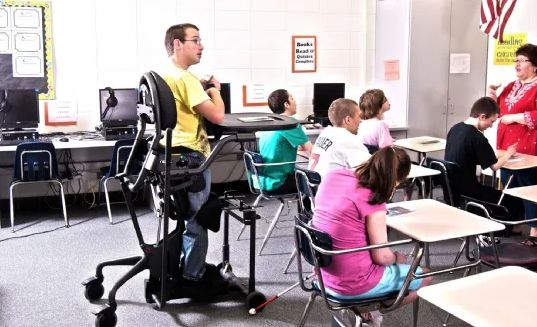
Any child who cannot stand independently can benefit from a pediatric stander. These can include children with spinal or head injuries or conditions such as cerebral palsy, spina bifida, muscular dystrophy, and multiple sclerosis. The need for standing is well-established, and getting kids upright has multiple therapeutic and social advantages.
Pediatric standers come in several designs, and they can carry some hefty price tags. A pediatric stander is considered to be Durable Medical Equipment and is categorized as Complex Rehab Technology. Medicaid will pay for medical equipment when it is determined to be medically necessary, cost-effective, and meets its strict definition of durable medical equipment. To be covered by Medicaid or other insurance, a prescription and demonstration of medical necessity will need to be a part of the application for coverage.
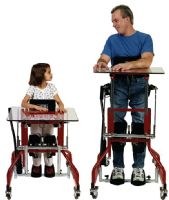 | Granstand III Modular Standing System View Product |
Making it to number 5 on our list is The Granstand III Modular Standing System by Prime Engineering! This versatile standing frame can be adjusted to accommodate various sizes and user growth. The completely modular system is suitable for people between 3 feet and 6 feet 5 inches tall, making it ideal for kids and adults of any age. The system is designed to adapt to users' changing bodies over time, with most growth adjustments requiring minimal time and cost. Its narrow width of 27.5" allows for extra mobility and function in various settings, including standard doorways.
This modular standing system is a highly adaptable standing frame suitable for individuals of all ages and sizes. It offers a range of customization options, including frame colors and adjustable features for upper and lower extremity positioning. The system's hydraulic lift mechanism allows for a smooth transition to weight bearing, and it can also double as a patient lift. The Granstand III is recommended for individuals with various diagnoses such as Muscular Dystrophy, Spinal Cord Injury, Parkinson's disease, Multiple Sclerosis, Cerebral Palsy, Dystonia, and Hypotonia. Overall, it is a versatile and functional choice for improving mobility.
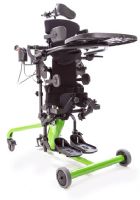 | EasyStand Bantam Small Stander Packages View Product |
The EasyStand Bantam Small Stander Packages made it to number 4 on our list because it provides a convenient Sit-to-Stand solution for children weighing under 100 pounds. This pediatric standing frame system is designed to offer children with disabilities a state-of-the-art solution for improving physical and social health. It features built-in sit-to-stand functionality and an optional supine mode, enabling children with limited mobility to enhance their overall well-being. The stander enlarges a child's interactive world by allowing access to countertops, shelves, and other areas that are ordinarily out of reach, while its mobile technology ensures that children with disabilities can engage with their peers, enhancing their sense of independence.
Each package comes equipped with default-sized foot holders, knee pads, back support, positioning belt, and head support, except for the mobile package. The packages are designed to cater to the specific needs of children and patients, offering four support packages, Minimum, Moderate, Mobile Moderate, and Maximum, each containing the same base support features with additional safety supports, pads, holders, and straps to support standing health and growth.
The Bantam Small Packages feature a sit-to-stand functionality ideal for transfers to and from other devices, while the supine upgrade accommodates children with more challenging conditions. The stander allows for infinite positioning possibilities, enabling adjustments to recline, back angle, and seat depth for maximum comfort and flexibility.
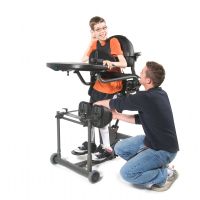 | EasyStand Original Evolv Sit To Stand Standing Frame Packages View Product |
EasyStand’s original Evolv Sit To Stand Standing Frame Packages made our list at number 3. The 2 sizes and 4 default packages make ordering easier, and optional additions make them customizable. Each package has a 3-point system that includes knee pads, seat, and chest pads.
Whether you need the Minimum, Moderate, Maximum, or Mobile Maximum configuration, these standing frames facilitate supportive self-transitions from sitting to standing. They are easily adjustable to create the perfect fit and create an environment conducive to improved circulation, muscle tone, and bone density.
The Evolv frame packages have been featured in many articles, including How to Choose the Best Pediatric Stander. For a super easy ordering experience and enough sizes and packages to meet almost any need, whatever model is best suited for your child will facilitate longer periods of standing to maximize the benefits of being upright.
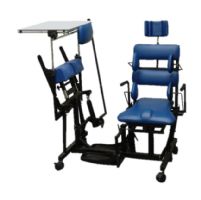 | Symmetry Solid Seat Stander and Positioning System View Product |
The Symmetry Solid Seat Stander and Positioning System made number 2 on our list because it's designed to provide proper posture and support while the user is standing, sitting, or during transition. The seat slides to eliminate shearing, and the open frame allows better access during transfers, even when a lifting device is needed. Available in youth or adult designs, it is the First Shear Reducing Standing System designed to supply proper positioning and support during the transition from sitting to standing. The stander is transfer-friendly, with armrests, lift arms, and knee supports that flip up and away for easy transfer, and an open frame design for close wheelchair access. It is available in sizes from youth to adult, covering a wide range of height sizes.
The Symmetry Stander's ability to put the body in correct full upright weight bearing and achieve mild hyperextension at the hips while reducing the negative effects of shear is unique and is the key to correct standing. It allows for maximum stretch and a progressive standing program, achieved through the Symmetry's unique design principles.
Reasons to Stand in Symmetry include over-center seat technology and shear reduction, sliding-seat technology that reduces the effect of shear during transitions, and an adjustable sliding-back system that allows precise back movement with proper alignment from sitting to standing. The Symmetry eliminates the effects of shear found in other solid seat standing systems, preventing unwanted postures and non-functional support surfaces.
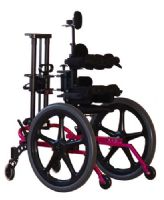 | KidWalk II Dynamic Mobility System View Product |
At the top of our list of best pediatric standers is the KidWalk II Dynamic Mobility System by Prime Engineering.
This assistive device simulates a natural gait, promoting independence and exploration for children with mobility limitations. It is considered one of the best gait trainers on the market, overcoming the movement limitations of most other gait trainers. Its large mid-wheel design allows lateral weight shift, upper body rotation over the pelvis, and upper extremity freedom of movement.
This system comes standard with single adjustment pelvic pads that support hip positioning, adjustable hip, and chest supports, auto-centering pelvic guides, vertical weight relief, lateral weight shift, angle adjustment mast, wheel locks, quick release wheels, anti-tippers, adjustable axle padded seat, and light up rear casters. The frame comes in two pieces so it is easy to break down for transport.
If you are seeking a pediatric stander for kids ages 5-12 that is also a gait trainer and will encourage independent movement, choosing the KidWalk II will open up opportunities for mental and physical development through self-initiated hands-free exploration.
Each of the pediatric standers on our list provides support to get children standing so they can have access to all the benefits that come from being upright. There are many levels of mobility, and regardless of your child’s mobility challenges, this list contains at least one appropriate assistive device that will be a good fit. The Rabbit-Up claimed the top spot on our list for its adaptability, age range of users, ease of use, and most of all the independence it provides for kids who can take advantage of the independent movement this device provides.
Standing is an important part of good health. In fact, home-based standing programs should include 30 minutes of standing 5 times a week for a positive impact. Although the designs and features vary, each of the pediatric standers on our list is a top-quality assistive device that will help your child at home, school, or in a therapeutic environment to be more independent and engaged while optimizing physical well-being and even social skills.
For more information about caregiving support and to learn more about helpful tools for the job of living, check out our comprehensive resource: Caregiver University.

Co-Founder of Rehabmart and an Occupational Therapist since 1993. Mike has spent his professional career working in multiple areas of Occupational Therapy, including pediatrics, geriatrics, hand therapy, ergonomics and inpatient / outpatient rehabilitation. Mike enjoys writing articles that help people solve complex therapeutic problems and make better product choices.